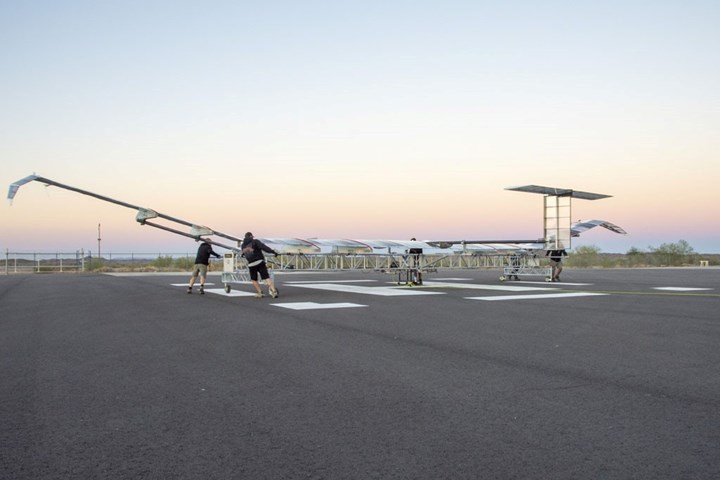Airbus concludes Zephyr HAPS flight test campaign
The composites-intensive Zephyr HAPS satellite is a stratospheric unmanned aerial system, which, with this recently successful flight test, is one step closer to providing local satellite-like services.

Photo Credit: Airbus
Airbus Defence and Space (Farnborough, U.K.) reported on Dec. 3 that it has successfully completed a new test flight campaign for its composites-intensive Zephyr High Altitude Platform Station (HAPS) in Arizona. Zephyr, a solar–electric, stratospheric unmanned aerial system (UAS), harnesses the sun’s rays, running exclusively on solar power above weather and conventional air traffic. According to Airbus, the station fulfills a capability gap complementary to satellites, UAVs and manned aircraft, and will provide persistent local satellite-like services, have potential to revolutionize disaster management and be able to provide communications to the most unconnected parts of the world.
The 2020 flight campaign was a success, says Airbus, despite global slowdowns due to the COVID-19 pandemic. It focused on aircraft agility, control and operations to build upon previous campaigns, which have already proven the day-and-night stratospheric persistence of the unmanned aerial system (UAS), which is essential in military and commercial markets.
In July 2018, the Zephyr team conducted a successful test flight campaign when Zephyr S flew in the stratosphere for nearly 26 days (25 days, 23 hours and 57 minutes). It remains the longest flight duration of an aircraft ever made without refueling. The aircraft persisted in the stratosphere day and night, consistently achieved a dawn altitude of 60,000 feet and its highest altitude of 71,140 feet.
This year’s campaign, held during the first three weeks of November, used a Zephyr aircraft, fitted with new software control systems and specific flight test instruments, plus associated lighter test aircraft to conduct multiple successful test flights. These tests aimed to demonstrate operational flexibility and aircraft agility, with a central focus on testing lower altitude flying and early stage transition to the stratosphere. It also enabled the validation of a new flight planning tool suite and the development of operational concepts through multiple, varied flights in short succession.
“Having proven stratospheric flight, we continue to further mature the operational system with the objective to be more flexible and robust in order to meet our customer needs. The outcome of this campaign is a valuable contribution to the full flight program next year,” says Jana Rosenmann, head of Unmanned Aerial Systems at Airbus.
The flights demonstrated take-off, climb, cruise, upgraded flight control and descent phases, followed by successful landings. The objectives of the test campaign were all achieved showcasing a more resilient and capable aircraft.
With the conclusion of this year’s successful test flight campaign, Airbus says Zephyr has come another step closer to an operational reality.
Related Content
-
Call for abstracts: CW Tech Days to explore high-temperature composite solutions
The fall 2025 installment of CW’s Tech Days online event series will cover high-temperature composite solutions for defense and space applications.
-
Syensqo composites demonstrate titanium replacement on Boeing MQ-25 Stingray
Validation of integrating Cycom 5250-4HT prepreg into the UAV’s exhaust nozzle structure underpins the material system’s use in other high-temperature aerospace applications.
-
Industrializing additive manufacturing in the defense/aerospace sector
GA-ASI demonstrates a path forward for the use of additive technologies for composite tooling, flight-qualified parts.



